Chapter Six
The Romantic Moses
On June 9, 1841, Jean-François Millet wrote from Paris to the Municipal Council of Cherbourg that it would soon receive, as a gift, a work now known as the Self Portrait as Moses (Plate 9).[01] The provincial authorities must have been taken aback by Miller's generosity, for relations between the twenty-seven-year-old artist and the city had not been altogether happy. Having come to Cherbourg in 1833 from the rural hamlet of Gruchy to pursue his art, Millet had received a scholarship from the city to study in Paris. But this support was terminated in 1839 when he dropped out of the Ecole des Beaux-Arts following an unsuccessful effort to win the Prix de Rome. More recently, Millet had protested the Municipal Council's bad faith in a portrait commission. The Self-Portrait as Moses , which has remained on the margins of Millet scholarship, deserves reconsideration, for it offers a poignant example of Mosaic imagery used in a discourse of legitimation and empowerment outside the realm of national politics.
The circumstances surrounding the creation of this work have been recounted by Millet's biographers, Etienne Moreau-Nélaton and Alfred Sensier. Early in 1841 the Municipal Council of Cherbourg had commissioned Millet to paint a posthumous portrait of Colonel Javain, a former mayor of the town. Millet was supplied with a poor miniature that dated from Javain's youth. He was to be paid three hundred francs for the portrait, intended for the assembly hall of the Municipal Council. The likeness presented to the council on March 30, 1841, however, was judged unsatisfactory (Fig. 84). The council's displeasure was aggravated by a rumor that Millet had modeled the portrait's hands on those of a boy who had
been imprisoned.[2] Millet defended his painting, arguing that the portrait conformed to the commission as he and the subject's son and son-in-law understood it. The work was not "a family portrait whose principal quality was its completely bourgeois resemblance"; it was intended, rather, to represent for posterity a man "worthy to fulfill the mission with which he was charged during his life."[3]
In response to the artist's demand for payment, the Municipal Council reached a compromise: one hundred francs, a third of the commission, would be paid to Millet provided that the portrait remain in Cherbourg. Before Millet learned of this, he wrote to announce his donation to Cherbourg of the Self-Portrait as Moses :
You will receive in a few days a painting that I beseech you to accept. I hope that this feeble result of my labors, so generously encouraged by you, justifies the expectation that determined your honorable choice. I have perhaps waited long to express my gratitude toward you; but you will understand, I am sure, that this delay was not caused by an ungrateful negligence. I have only waited until I felt capable of delineating some work worthy of you. In the painting that I submit to your good will, I have sought to represent Moses. I did not believe that I could offer a subject more appropriate to the magistrates of the city of Cherbourg than the image of this ancient and severe legislator of the Hebrews. I can only testify anew, Messieurs, to the gratitude of a schoolboy, whose first efforts have been aided by you, and to his keen desire to succeed in bringing you satisfaction.[4]
Making reference to Miller's terminated scholarship, this letter was written in a tone of mock humility that masks a spirit of defiance. Moreau-Nélaton has detected "a light touch of malice" in Millet's choice of subject.[5] and certainly the contrast between the "ancient and severe legislator of the Hebrews" and the provincial Municipal Council is comic. But this interpretation does not give sufficient weight to the aggressiveness of Millet's gesture.
The most audacious aspect of the work is the resemblance to the artist, evident in a comparison to Self-Portrait , a drawing of 1845-46 (cf. Plate 9 and Fig. 85). The arrogance of the assumed biblical identity is reinforced by Moses' assertiveness in facing the viewer as he points to the Ten Commandments. A portion of the frowning hawk-like countenance is illuminated against a mass of dark hair
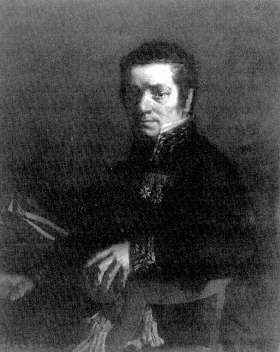
Fig. 84.
J.-E Millet, Portrait of Colonel Javain ,
1841. Musée Thomas Henry, Cherbourg.
and beam that set the nose into Semitic prominence. The horned silhouette is enhanced by a zone of light in the sky, suggestive of divine inspiration.
The defiance underlying Miller's gift to Cherbourg is even clearer in light of the idea that the artist and the poet were the true legislators of mankind,[6] a notion, embraced by utopian theorists under the July Monarchy, that had become a rhetorical commonplace in Paris by 1841. The Saint-Simonian Emile Barrault, for example, said of the artist: "In his free flight, he soars above the earth, and from the sky his inspired and often prophetic voice can be heard. . . . The artist alone. . . by the power of the sympathy that makes him embrace God and society, is worthy to direct humanity."[7] This strain of utopian rhetoric was also pursued in references to Michelangelo's Moses as "the legislator-poet."[8] Miller's identification with Moses thus proclaims the artist's independence, dignity, and authority.
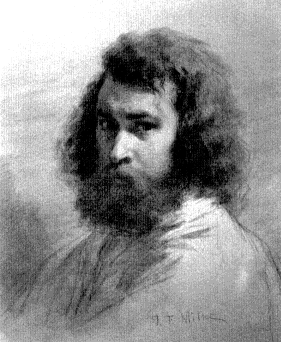
Fig. 85.
J.-E Millet, Self-Portrait , 1845-46.
Cabinet des Dessins, Louvre, Paris.
The relevance of the Self-Portrait as Moses to Millet's dispute with the Municipal Council is also suggested by the gesture ("undecipherable" to one commentator) with which Miller's Moses points to the number of the Eighth Commandment.[9] The Eighth Commandment prohibits bearing false witness, the transgression Millet perceived as that of his patron. In treating Millet as an artisan and in rejecting the Javain portrait, the Municipal Council was belying Miller's calling as well as violating a contract. For Millet, the portrait would have borne false witness if he had imitated a mediocre miniature.
A Moses comparable in severity to that of Miller's self-portrait was prominently placed in Paris early in 1841, when Henri de Triqueti's monumental bronze doors representing the Ten Commandments were moved from the founders' studio, where they had been on display, and installed at the church of the Madeleine. The forbidding Moses on the lintel resembles that of the Self-Portrait as Moses
(cf. Plate 9 and Fig. 50). Triqueti illustrated the Eighth Commandment with the judgment of Susanna and the punishment of the perjuring elders—a story relevant to Millet's dispute with the Municipal Council.
As a veiled gesture of independence, Millet's Self-Portrait as Moses prefigures Courbet's Studio of the Painter (1854-55); there Courbet asserted his artistic and moral authority after refusing Count de Nieuwerkerke's offer of government patronage.[10] The Self-Portrait as Moses reflects an aggressive self-aggrandizement that, some twelve years later, Delacroix found annoying. With aloof displeasure Delacroix described a meeting with Millet:
During the morning, somebody brought Millet to me. He speaks of Michelangelo and the Bible, which, he says, is or almost is the only book that he reads. That explains the rather ambitious character (tournure ) of his peasants. . . . He is certainly of the constellation or squadron of bearded artists who made the revolution of 1848, or who applauded it, apparently thinking that there would be equality of talents, as well as fortunes.[11]
Delacroix's disparagement of Millet as a bearded revolutionary who invested lowly subjects with inappropriate grandeur suggests the character of the young artist who painted the Self-Portrait as Moses . Millet portrayed himself with the full beard that, as Robert L. Herbert has observed, identified him with artists, writers, philosophers, and religious leaders rather than the bourgeoisie of Cherbourg.[12]
In combining earthy realism and lofty reference, the Self-Portrait as Moses prefigures Millet's bold imputation of biblical and Michaelangelesque qualities to rural imagery, disliked by Delacroix and the mid-century Salon audience. At the same time, the very obscurity of the Self-Portrait as Moses suggests the problem of Millet's private appropriation of the theme of divine legislation.[13]
Millet's view of Moses as a source of legitimacy and authority is related to the ongoing tradition of Mosaic imagery in French official art. The Self-Portrait as Moses also continues a tradition of self-aggrandizement through biblical reference established by the young poets of the 1820s. Victor Hugo, like others in the circle of the short-lived Catholic and ultra-royalist literary magazine La Muse française (July 1823-June 1824), cherished a belief in the priestly and prophetic functions of the poet.[14] Accordingly, he turned to Scripture in evoking the poet's authority in "Le Poète" (1823; published 1824):
Les peuples prosternés en foule l'environnent;
Sina mystérieux, les foudres le couronnent,
Et son front porte tout un Dieu![15]
Crowds bow down before him;
Inexplicable as Sinai, he is crowned with thunder,
And his brow shines with divine radiance!
The prophet-poet, like Moses, stands amid the thunder of Sinai with a radiant brow (which one is tempted to associate with Hugo's own prominent forehead). Hugo employed similar imagery to honor his colleague Lamartine:
Chante, juge, bénis; ta bouche est inspirée!
Le Seigneur en passant t'a touché de sa main;
Et, pareil au rocher qu'avait frappé Moïse,
Pour la foule au désert assise,
La poésie en flots s'échappe de ton sein![16]
Sing, judge, bless; your tongue is inspired!
The Lord, in passing, touched you with his hand;
And, like the torrent from rock that Moses struck
For the multitude in the desert,
Poetry flows from your breast!
Hugo's scriptural reference reflects the literary prestige of the Bible early in the 1820s. But his use of Mosaic imagery is hardly religious. It resembles the secular transvaluation of Mosaic imagery by another young member of the circle around the La Muse franéaise , Alfred de Vigny.[17]
Like Hugo's verse of the early 1820s, Vigny's "Moïse" (1822), though full of biblical reference, is entirely secular. Conflating the death of Moses (Deuteronomy 34) with the terrifying spectacle on Mount Sinai (Exodus 19-31 and Deuteronomy 5), Vigny gives Moses an overpowering individual presence at variance with the traditional conception of him as the obedient servant of God.[18] As Moses ascends Mount Nebo to meet his death—with six hundred thousand terrified Hebrews "bowed in the dust" below—he enumerates the divine powers he has received from God:
J'impose mes deux mains sur le front des nuages
Pour tarir dans leurs flancs la source des orages;
J'engloutis les cités sous les sables mouvants;
Je renverse les monts sous les ailes des vents;
Mon pied infatigable est plus fort que l'espace;
Le fleuve aux grandes eaux se range quand je passe,
Et la voix de la mer se tait devant ma voix.
I grasp the clouds with both hands
To dry up the source of storms in their flanks;
I bury cities under moving sands;
I topple mountains under the force of winds;
My tireless tread cannot be outdistanced;
The mighty river makes way when I pass,
And the voice of the sea falls silent at my voice.
This demigod, the envy of the angels, is filled with a melancholy alien to the biblical Moses. Like Job, Jeremiah, and Christ, Vigny's Moses laments the solitude that has been the cost of God's choosing him:
Sitôt que votre souffle a rempli le berger,
Les hommes se sont dit: Il nous est étranger;
Et leurs yeux se baissaient devant mes yeux de flamme,
Car ils venaient, hélas! d'y voir plus que mon âme.
J'ai vu l'amour s'éteindre et l'amitié tarir,
Les vierges se voilaient et craignaient de mourir.
As soon as your spirit passed into the shepherd,
Men said to themselves, He is a stranger to us,
And lowered their eyes before my flaming eyes
Because they had, alas, seen more there than my soul.
I have seen love extinguished and friendship dried up;
The virgins covered themselves in fear of death.
Weary of solitary grandeur, Moses asks God for the repose of death:
O Seigneur! j'ai vécu puissant et solitaire,
Laissez-moi m'endormir du sommeil de la terre.[19]
Oh Lord! I have lived in power and solitude;
Let me sleep the sleep of mortals.
Vigny's Moses is particularly unorthodox when he is compared with the Moses of Bossuet's Discours sur l'histoire universelle (1681), who dies content.[20] The grandiose narcissism of Vigny's Moses, moreover, was the very stuff of Romantic theater, as was the unrecognized young poet in Vigny's Chatterton , whose suicide in the face of bourgeois indifference created a sensation among Parisian audiences in 1835.
The critic Charles Magnin appreciated the tragic and secular elements of "Moïse," writing in the liberal paper Le Globe of Vigny's "sad and great idea, a modern idea that brings new life to an ancient myth whose primitive meaning had been weakened or lost." As Vigny severed his Moses from Scripture, he also transformed the solitude and frustration of his protagonist, by a Romantic alchemy, into attributes of empowerment and aggrandizement. Magnin wrote that Vigny evoked "that melancholy of omnipotence, that sadness of a superhuman superiority that isolates; that weighty disgust of genius, of command, of glory, of all those things that make of the poet, of the warrior, of the prophet a gigantic and solitary being, a pariah of grandeur."[21] Some sixteen years after writing "Moïse," Vigny offered a similar interpretation of the poem, which he then considered his best, for "its sadness." His Moses, he explained, "is not that of the Jews. This great name only serves as a mask for a man . . . more modern than antique: the man of genius, weary of his eternal widowhood and despairing to see his solitude all the more vast and more arid the more he grows."[22]
Vigny's "Moïse" and his gloss on the poem reflect the Romantic inclination both to elevate the "man of genius" by references to Moses (as in Millet's Self-Portrait as Moses and in the two poems by Hugo already discussed) and to reconstitute the biblical personage who is an instrument of Providence into a mighty individual will. From this perspective, Vigny's reinterpretation of the biblical Moses echoes the cult of the divine lawgiver that flourished under Napoleon.
The Romantic enhancement of Moses' stature as an individual is perceptible even amid the orthodoxy of the competition for the Prix de Rome. This contest, judged on the traditional academic criteria of composition, drawing of the nude, expression, and command of ancient history and literature, offered young artists the opportunity to study in Rome that Millet had been denied. Biblical subjects
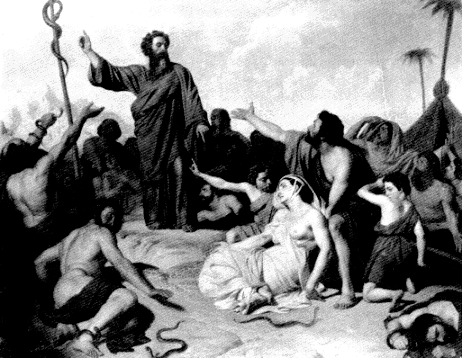
Fig. 86.
E. Roger, Moses and the Brazen Serpent , 1833.
Ecole Nationale Supérieure des Beaux-Arts, Paris.
were not unusual in this competition, beginning with Moses, Overcome with Indignation at the Sight of the Israelites Adoring the Golden Calf, Breaks the Tablets of the Law (1663).[23] Poussin and Racine had established Old Testament narrative as part of the French classical tradition. In 1833 the Academy of Fine Arts offered Moses and the Brazen Serpent as the competition subject, a story (Numbers 21) of revolt, punishment, and reconciliation. God sent venomous snakes to attack the Hebrews in the desert after they began to grumble about Moses' leadership and the folly of having left the relative comfort and security of Egypt. Acting under divine inspiration, Moses raised a staff surmounted by a serpent of bronze
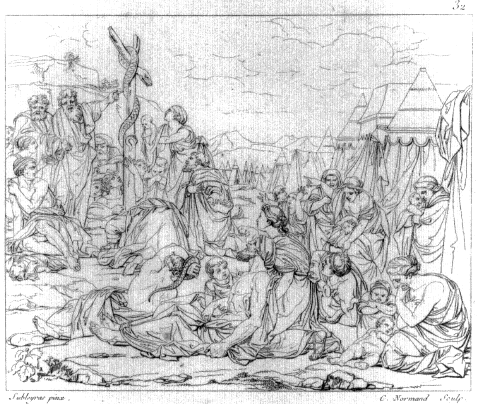
Fig. 87.
C. Normand after P. Subleyras, The Brazen Serpent (1727),
from C. P. Landon, Annales du Musée , vol. 2, Paris, 1803, plate 32.
that had healing power for the Hebrews who would look on it. This episode, in the Christian iconographic tradition, prefigured salvation through Christ.
The composition of the winning entry in 1833 (Fig. 86), by Eugene Roger (1807-184o) was reminiscent of that of the winning entry of 1727, by Pierre-0 Hubert Subleyras (1699-1749). Subleyras's painting, much admired in the early nineteenth century, was reproduced in the 1802 and 1835 editions of Landon's Annales du Musée , an illustrated compendium of old master and contemporary paintings (Fig. 87).[24] Roger's modern sense of archaeological decorum—evident in the bamboo staff, the palm trees, and the detailed headdress of the recumbent
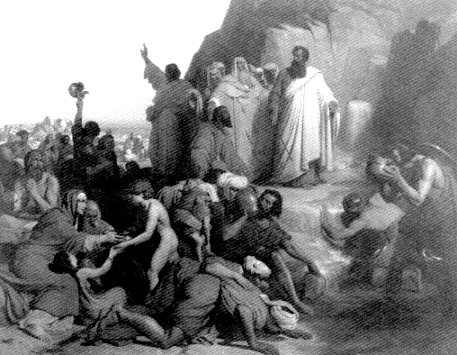
Fig. 88.
D.-L.-E Papety, The Striking of the Rock , 1836.
Ecole Nationale Supérieure des Beaux-Arts, Paris.
woman—however, departs from its classical prototype in giving prominence to Moses. Silhouetted against the sky, Roger's Moses combines the authoritative gestures of Plato and Aristotle in Raphael's School of Athens . He stands on raised ground, fully clad, above the seminude crowd at his feet.[25]
The Mosaic subject for the 1836 competition was the Striking of the Rock. A critic reviewing the entries in L'Artiste protested the Academy's choice of a theme so ambitious that most of the contestants have been "crushed by their subject"—a theme that called for no less than "the vast, profound, austere genius of Nicolas Poussin."[26] It was not surprising that the two winners, Dominique-Louis-Ferréol Papety (1815-1849) and Charles-Octave Blanchard (1814-1842) turned to Poussin
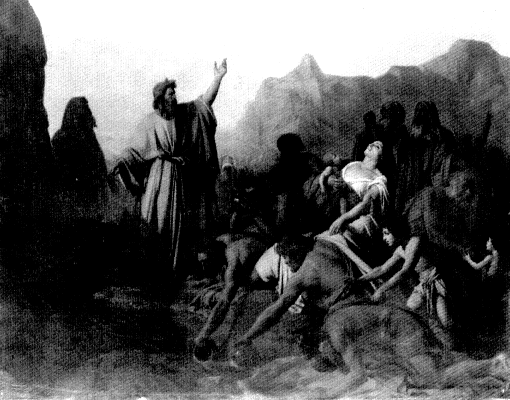
Fig. 89.
C.-O. Blanchard, The Striking of the Rock , 1836.
Ecole Nationale Supérieure des Beaux-Arts, Paris.
(cf. Figs. 88-90). Papety, though he emulated the seventeenth-century master, emphasized Moses (whose prominent forehead and angular nose imitate those of Michelangelo's figure in San Pietro in Vincoli) in a characteristically nineteenth-century way.[27] The critic in L'Artiste wanted more: "The head of Moses has a handsome character, but it does not sufficiently dominate the crowd."[28] And Blanchard's painting, like those of Roger and Papety, melodramatically contrasts the untroubled authority of Moses with the heartfelt vulnerability of the crowds at his feet.
Chateaubriand's sole theater piece, Moïse (c. 1811-28)—a dramatic poem in the manner of Racine's Athalie —was an ambitious attempt to represent Moses in
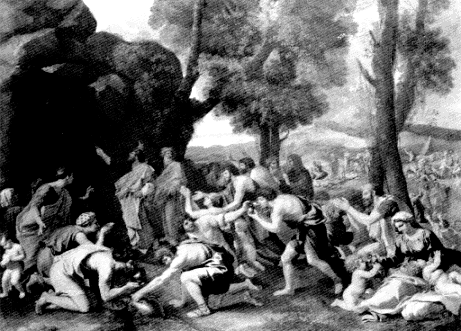
Fig. 90.
N. Poussin, Moses Striking the Rock , c. 1637.
Duke of Sutherland Collection (on loan to the
National Gallery of Scotland, Edinburgh).
the language of French classicism.[29] Although in the Génie du christianisme Chateaubriand recommended the subject of Moses to poets, in the preface to Moïse , published in his Complete Works , he begged his readers' indulgence. Even Racine, he pointed out, was sometimes unequal to his scriptural source. And Chateaubriand had dared to conceive of a theater production featuring "that legislator with rays of fire on his brow, that prophet who delivered Israel, struck Egypt, opened the sea, wrote the history of Creation . . . and spoke to the Lord face-to-face." He predicted ("without vanity, for it is a question of material effect independent of the author's talent") that such details as "the descent of
Moses from Mount Sinai, by the light of the moon, bearing the tablets of the law [and] . . . the sets representing the Red Sea in the distance, Mount Sinai, [and] the desert with its palm trees" would bring variety and movement to classical tragedy.[30] Accepted by the Théâtre-Français in 1828, the work was staged October 2, 1834, at the Théâtre Municipal de Versailles under the title Moïse au mont Sinaï; ou La Première Idolâtrie . This spectacular flop saw five performances at Versailles and one at the Odéon in Paris.
Writing in L'Artiste , a professed admirer of Chateaubriand awaited the premiere with "astonishment and profound chagrin." For the "sublime child" had written Moïre as if it were to be played "in the presence of Mount Sinai, with the sound of thunder, by the glare of lightning." Chateaubriand had conceived the work without recognizing the limitations of "a theater of boards . . . a cardboard mountain, a sky of blue cloth . . . [and] players in flesh and blood."[31] The critic's apprehensions were borne out when, according to an anecdote attributed to Chateaubriand himself, such mirth greeted the production that Chateaubriand's butler congratulated him on the success of his comedy.[32] Sainte-Beuve aptly characterized this pompous creation: "Ô ennui! noble ennui!"[33]
Just as the Prix de Rome entries imply a revised conception of Moses, so too the range of responses to Michelangelo's representation of him (Fig. 91) suggests the protean vitality of the Romantic Moses. In the late eighteenth century the statue, whose awesome authority would so impress Freud, was not universally appreciated.[34] Repulsed by it, Francesco Milizia denounced it in terms approvingly paraphrased by Joseph de Maistre: "a satyr head with pig bristles . . . a frightful boor enveloped in the costume of a baker."[35] For the sculptor Etienne-Maurice Falconet (1716-1791), who likened the Moses to a convict, the figure Michelangelo had made fell far short of the magnificent original.[36] Seroux d'Agincourt, however, in his ground-breaking history of Italian art, published 1811-23 but written in the decade before the French Revolution, offered a very different opinion, which would be echoed in the nineteenth century: the Moses was Michelangelo's greatest work and perhaps the capital achievement of modern sculpture.[37]
The evocative force of Michelangelo's Moses for the Romantic period is suggested by the cloud of extraneous associations that interferes with the representation and description of the object. Two engravings (Figs. 92, 93) are telling examples. The first, included by Seroux d'Agincourt in his work on Italian art,
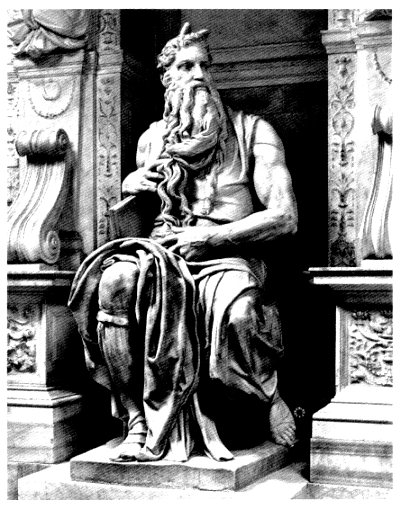
Fig. 91.
Michelangelo, Moses , c. 1515. San Pietro in Vincoli, Rome.
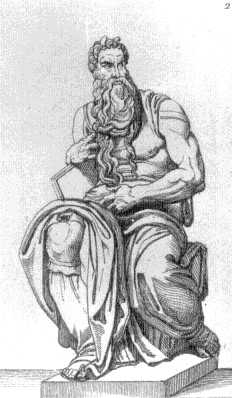
Fig. 92.
Michelangelo, Moses , from J.-B.-L.-G. Seroux
d'Agincourt, Histoire de l'art par les monumens,
vol. 4, Paris, 1823, plate 47, Avery Library,
Columbia University, New York.
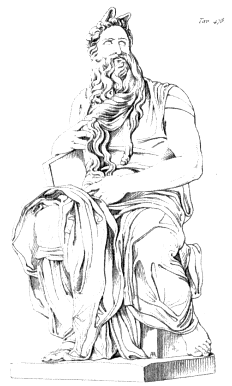
Fig. 93.
Michelandgelo, Moses , from Musée de
peinture et de sculpture , vol. 13, Paris,
1832, p. 924. Thomas J. Watson Library,
Metropolitan Museum of Art, New York.
overemphasizes the curling musculature of the arms and lends a satyric expression to the face. Whereas Moses was Hellenized in this late eighteenth-century illustration, he was baptized in an engraving published in the Musée de peinture et de sculpture . Here the incision of pupils is omitted and the face given a slight backward tilt, suggesting a gaze upward with rolled eyeballs that is as reminiscent of ecstatic saints as it is foreign to the Moses of Michelangelo.
The Moses was canonized by a critic as well. Gustave Planche, in an 1834 article on Michelangelo, spoke of it as a figure of tearful and saintly majesty that
produced "a mixture of sadness and veneration, a religious seizure, a shiver of pious ecstasy." In the expression of the Moses Planche perceived "a complete resignation, an absolute abnegation, a devotion without reserve"—in short, an Old Testament saint, who has shed generous and sympathetic tears: "Moses has wept, but wept on wounds he could not heal."[38]
Alexandre Dumas père, writing in L'Artiste in 1845, was impressed, on the contrary, by the animal energy and physicality of the Moses ; he described the figure as a demigod seated in Olympian majesty with a "thick and secular beard spread in waves upon his vast chest like an overflowing torrent." Dumas compared the rays the sight of Jehovah had left on Moses' forehead to the horns of a goat:
This emblem of savage energy and animal force adds I know not what of the strange and formidable to the physiognomy of the colossus; because, in truth, whether man or monster, reality or symbol, this being thinks, and the Hebrew people, as a poet [Vigny] said, would not have been entirely wrong to prostrate themselves before him. [ 39]
So overpowering is Michelangelo's Moses that Dumas declares it beyond the grasp of reason and taste:
I pity the critics who have wanted to measure this giant according to their own dwarfish stature: so much grandeur crushes them. Here it is necessary to feel rather than reason. . . . It is a strange and colossal dream, translated into marble, during a night of insomnia and terror. [40]
Dumas's overblown evocation of the Moses , in which he pays homage to the Romantic cult of genius, is also pitched to a nostalgia for authority that had crowd-moving force in post-Napoleonic France—as when, for example, the emperor's remains were returned to Paris.
Like Vigny's "Moïse," Dumas's description of Michelangelo's Moses secularizes and magnifies the biblical lawgiver. While this treatment of the theme contrasts with Millet's and Hugo's self-aggrandizing identification with Moses, both tendencies echo the discourse of legitimacy and authority associated with the law in official art since the French Revolution. The diversity of sentiment that found
expression through reference to Moses under the Restoration and July Monarchy suggests that the figure of the lawgiver remained evocative for artists and writers when the cult of the law was in decline.